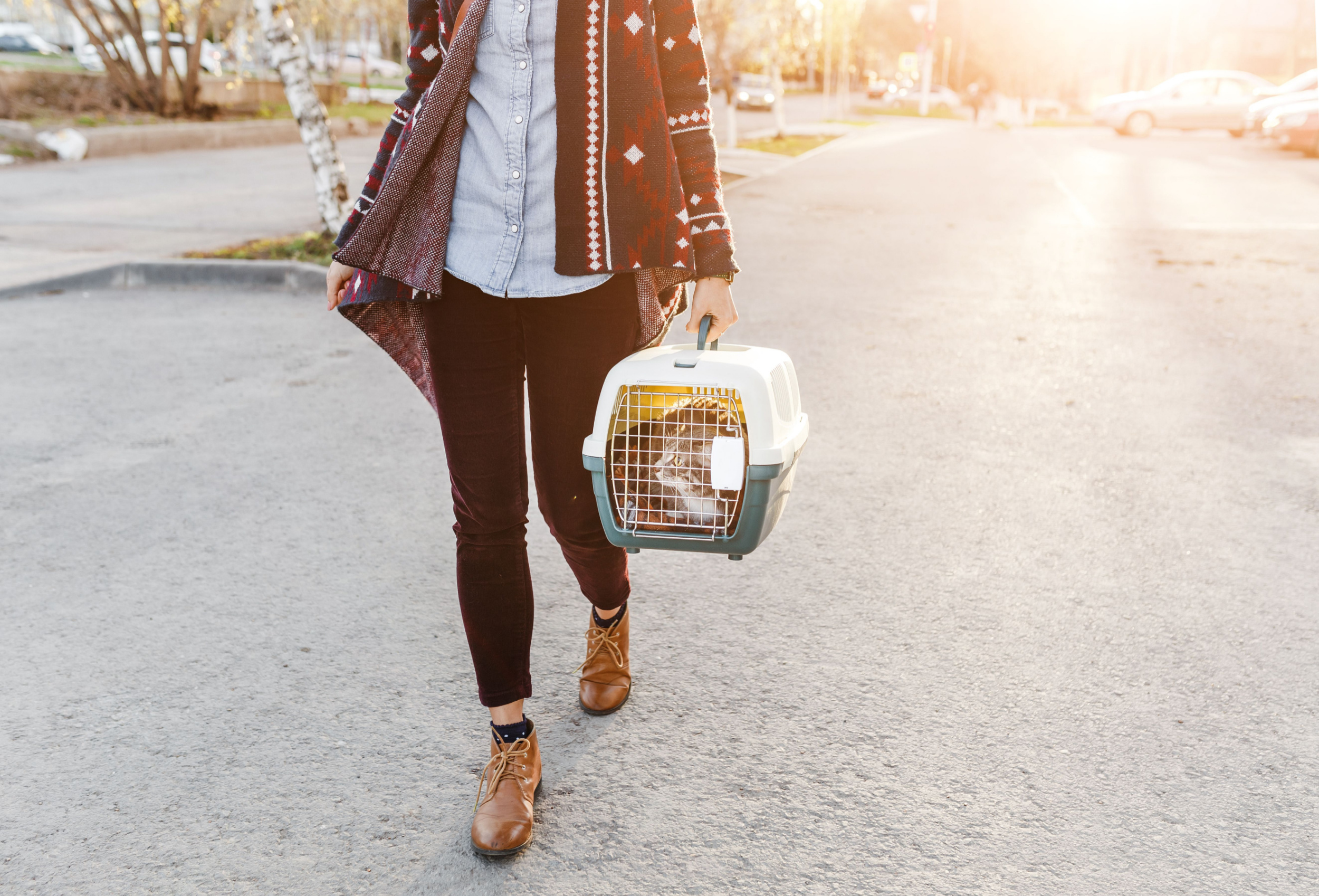When deciding on modes of transportation, you look for safety, comfort, affordability, and durability. The same standards apply when you are selecting a transportation for your cat.
Choosing the right carrier for your cat is a worthwhile investment since a good carrier provides your cat with an extra level of security and can help make travel less stressful for both you and your cat.
Transporting a cat without a carrier can be dangerous for you and your cat. A loose nervous cat can climb anywhere in the car, including under your pedals, in front of your dashboard, or in your steering wheel. If the cat becomes frightened, it could scratch, bite, or impede your ability to drive safely. A cat who is not secured in a carrier can bolt from the car or from your arms and can get lost or injured before you can react.
What makes a good carrier? When you go to the pet store or look online there are a wide variety of carriers (soft-sided, hard plastic, colorful, big, little, cloth, cardboard, and much more). How do you decide?
Let’s look at it from the cat’s perspective. Cats like comfortable, cozy, dark enclosed spaces, which is the reason you will find them hiding out in paper bags, cardboard boxes, baskets, and such. It gives them a sense of security. When they are stressed or frightened, they like to make themselves “invisible.” Choosing a carrier that provides all the above will help your cat feel safe and secure when traveling.
Size Matters
- Cats should be able to stand, sit and turn around in their carrier.
- Generally, a carrier should be one and a half times the size of your cat.
If the carrier is too big, it can be uncomfortable trying to balance and carry it without your cat sliding from one side to another. No cat likes to travel like they are on a ride at an amusement park. When buying a carrier for your kitten, choose a regular-sized carrier that you think will be appropriate when they have reached their adult size. Lining the bottom of the carrier with a thick towel will help the kitten from slipping and sliding during travel.
If you are going to be traveling further than a quick trip in your town, be sure the carrier can accommodate food and water bowls. If you are traveling very long distances, you can choose a larger crate (made for traveling with dogs) that can house a litter box and a bed.
Carrier pooling is not ideal.
In most cases, it is better to have separate carriers that fit each of your cats than having them travel together in one big carrier. It can be awkward and uncomfortable having a single cat travel in an extra large carrier. Cramming two cats into one smaller carrier is difficult, uncomfortable, and very stressful. Even cats who are normally very bonded can show aggression towards one another during the trip if one is stressed. Sometimes there is a peaceful trip to the animal hospital, but during the return trip from a veterinary visit, a stressed cat can show aggression to the other in the carrier. A cat who is the victim of an aggressive event in the carrier will be much harder to get into the carrier the next time.
Styles
Cardboard
This is a temporary transport. Most cardboard carriers are the same size and do not allow for the cat to comfortably turn around. Some cats will chew through the cardboard. It is not easy to clean if the cat soils it during travel or disinfect if your cat has a contagious disease (ringworm, upper respiratory infection, etc). It is harder to secure the opening so there is a risk of the cat pushing or pulling his way out of the carrier in a parking lot or other dangerous places.
Soft Carriers
These are usually made with firm but flexible materials. They are not as bulky as hard plastic carriers, but some are not as sturdy or supportive as hard plastic carriers. Many soft carriers have more than one opening. They also may be harder to clean if your cat gets carsick. Cats who like to scratch may tear up or wear down the carrier. Some cats can push their way out of the carrier where you zip it closed.
Rolling Suitcase Style Carriers
A rolling carrier is easier for families who have a hard time carrying things, since they can roll the cat where they need to go. If you must tilt the carrier to roll it, this can cause the cat to have to sit in an uncomfortable position and can be stressful. They tend to be hard to clean if they have been soiled. Some cats can be frightened by the loud and bumpy movement of being rolled across pavement.
Hard Plastic Carriers
An appropriately sized hard carrier gives more room for the cat to turn around and stretch while still allowing for the feeling of security. They are easy to clean if soiled. They are also more durable than the above carriers. Most allow for the top to be taken off and/or have more than one door for easier, less stressful access to inside the carrier.
Features
Single vs. Multiple Doors
A single door only allows one point of entry for your cat. If you have a fearful cat or one who resists going into the carrier, multiple ways to help guide your cat into the carrier allow for an easier time for the family. Some families find it easier to put the cat in the carrier through the top with minimal stress versus trying to coax their cat through the front door. This also allows the veterinarian to have a variety of ways to access the cat without having to remove the cat from the carrier.
Screws
If they are not rusted, screws are an easy way to take the top off the carrier so your cat can be examined while still in the bottom of the carrier. It is a little more time-consuming than other methods of taking the top off the carrier. Screws are easy to replace if lost.
Side Snaps
A quick and easy way to latch/unlatch the top of the carrier for ease of taking the top off the carrier. The sound when snapping the carrier closed can be loud and scary for a cat in the carrier. The snaps can wear down over time and not latch fully. Carriers with side snaps usually need to be replaced more frequently than other varieties.
Plastic Pegs
Quick and easy way to latch/unlatch a carrier top to take off. Some pegs can be easily lost and hard to replace.
Sliding Plastic Locks
Can be quick and easy to latch and unlatch the carrier top. These are not very loud when unlatching or latching. Can be confusing to people who are unfamiliar to them.
Zippers/Velcro/Snaps
Quick and easy. Not recommended for cats that can push their way through the opening. Velcro can be loud and sound like a hissing noise, further stressing an already anxious cat.
So now how do you decide?
The carrier should be user-friendly and something that will not cause you stress to use. It should be easy to clean, cozy, and comfortable for the cat. And it should be veterinarian friendly.
For many cats, the only trips they will take is the veterinarian’s office. Making the carrier a safe haven away from home will help decrease your cat’s stress during their visit. Having a towel or bed in the bottom of the carrier allows for familiar scents for your cat along with giving them something cozy to rest on and preventing them from sliding in the carrier. You can also calm cats by spraying the bedding and carrier with Feliway pheromone spray about 30 minutes before you place the cat in the carrier.
An appropriately sized carrier with a towel or bedding in the bottom will prevent your cat from sliding around in the carrier, which will help with carsickness. If the cat does get carsick, urinate, or defecate, an easy-to-clean carrier will allow for the exam room team to clean the carrier so the cat does not have to ride home in the remnants of eliminations or vomit. The towel or bedding can soak up any urine so the cat is not covered in it.
The carrier should be well-ventilated but can be covered by a light blanket or towel to create a dark and protected space your cat can feel safe. There should be multiple entry points or doors so the cat has options when starting to explore or look around from the safety of the carrier. This also allows for a less stressful way to coax your cat in or out of the carrier.
Cats prefer to feel their back up against something, which creates security. This is why you will see them head for the sink or corner or sit on the scale during the visit. There is security in knowing that they will not be ambushed from behind. If the carrier top can be removed, the veterinarian can examine the cat in the carrier for some portion of the physical exam. Towels can be placed over the top of the carrier during the exam to create a dark, cozy safe place for the cat to hide their head. This can make a huge difference in the cat’s whole veterinary experience.
To learn more about choosing a carrier and training cats to use it, please watch this video:
Cats and Carriers: Friends, not Foes
Adapted from Animal Hospital of North Ashville’s Choosing the Right Cat Carrier

